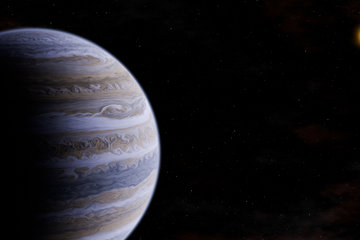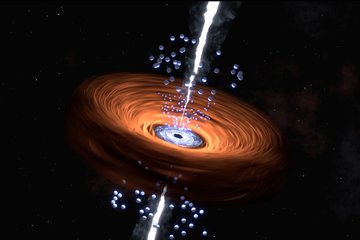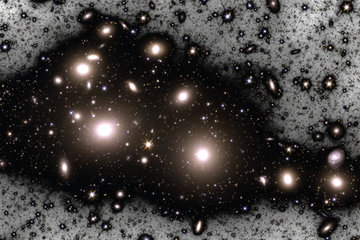“The galactic centre offers fantastic opportunities”
Interview with Reinhard Genzel on his observation of an effect of the general theory of relativity
It is highly likely that there is a black hole at the centre of the Milky Way. The astronomers working under Reinhard Genzel, Director of the Max Planck Institute for Extraterrestrial Physics in Garching near Munich are making repeated detailed studies of the surrounding area of the gravitational trap. Now, the researchers have succeeded in making a huge achievement in the art of observation: from the motion of a star called S2 around the black hole, which is 26,000 light years away, they have measured an effect predicted by Albert Einstein known as the gravitational redshift. What is so special about this observation?

You have been studying the surrounding area of the black hole in the centre of the Milky Way for more than 20 years. Were you specifically looking for the gravitational redshift that you have now discovered, or did this happen by accident?
No, the discovery was by no means accidental. We’ve been systematically looking for this and preparing the experiment for ten years now. We’ve known for a long time that the object in the galactic centre has a very high mass, and that it is highly plausible that it is a black hole. However, there’s a difference between plausibility and physical certainty. That’s why we design all kinds of tests, for which the centre of our Milky Way offers wonderful opportunities. In short: our current measurement of the gravitational redshift is already providing very strong evidence of the existence of the black hole in the galactic centre – and of the general theory of relativity.
The current observations are taking place on the margins of what is measurable. What instruments did you need in order to achieve your successful result?
Certainly, measurements like these would not have been possible just a few years ago. At that time, we observed the centre of the Milky Way using a single eight-meter mirror in the Very Large Telescope. Now, we us all four telescopes in the system in Chile at the same time by using interferometry. In radio astronomy, this procedure, in which the waves of an object overlap and this appears sharper as a result, has already been established for decades, but not in the field of optics. For this reason, the Max Planck Institute for Extraterrestrial Physics headed by Frank Eisenhauer, together with the Max Planck Institute for Astronomy, the European Southern Observatory, the University of Cologne, two French CNRS institutes and institutes in Porto and Lisbon, has developed a highly complex instrument called Gravity. Gravity processes the signals of the four individual telescopes and offers a huge improvement in the detail resolution in the infrared range. This means that thanks to Gravity, the Very Large Telescope could in theory provide images of two adjacent two-euro coins on the moon. It’s no exaggeration to say that Gravity has led to a breakthrough in the field of optics in matters relating to interferometry.
A key role during observation is probably also played by adaptive optics. What’s the reason for this?
Turbulences in the Earth’s atmosphere distort the wavefronts of the stars’ light. In principle, the aim is to compensate the crests and troughs of waves. This is made possible through the use of a mirror in the telescope, which has mechanical tappets attached to its rear side. These so-called actuators deform the surface of this small mirror in the beam path up to a thousand times per second, and in this way eliminate the distortions. In this way, we achieve the theoretical resolution of the telescope – and this is higher by a factor of ten than those that are achieved without correcting the air turbulence.
You said that the centre of the Milky Way offers wonderful opportunities to finally put the general theory of relativity to the test ...
... and the redshift measured by us is one of these tests. In this regard, it’s important to realise that such a redshift is not just caused by the Doppler effect. We know this from everyday life when for example an ambulance drives past us, and the tone level of the siren increases and decreases. At the same time, this means a displacement of the wavelength into the short- or long-wave range. This also occurs with light waves, where reference is made to blueshift or also redshift. This aside, according to the general theory of relativity, a redshift also occurs in the field of gravity when light moves there and fights against it to a certain degree. This effect also has an impact on the radiation of the S2 star, which approaches the black hole up to a distance of around 14 billion kilometres – which is the equivalent of three times the distance between the planet Neptune and the Sun. On 19 May of this year, S2 again passed the place where the distance was lowest during its orbit. For us, this offered a unique opportunity to measure the gravitational redshift.
Can you foresee conducting further tests for the general theory of relativity?
Yes, another test would be the Schwarzschild precession. This sounds complicated, but in fact, it’s simple. According to the general theory of relativity, celestial bodies that move around a central mass do not run on closed trajectories. The point of the greatest approximation, the perihelion, constantly continues to move in space. This can be clearly observed with planet Mercury, the perihelion rotation of which has been known for a long time. Its measured value correlates precisely with Einstein’s prediction. It is likely that a similar effect can be observed in the orbits of stars that move around the central black hole of the Milky Way. Indeed, we are already seeing the first signs of this. In two years’ time, we should then have statistically significant measurements. The best test for the general theory of relativity would otherwise be when a star falls into the black hole in front of our eyes. Unfortunately, statistically speaking, this happens only once every 10,000 years.
The gravitation effect measured by your group is a wonderful piece of evidence supporting Einstein’s theory of relativity. Is there any doubt at all now about the validity of this theory?
Yes, certainly! To put it in drastic terms: the physical laws known to us to date only apply to a limited range of parameters. The tiniest and the largest in particular, namely quantum physics and the theory of relativity, do not match each other. And so far, a corresponding quantum theory of gravitation has not yet been developed.
Interview: Helmut Hornung












